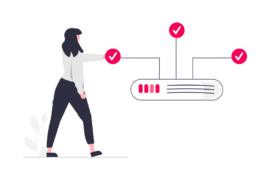Find out EBDA meaning, and how it allows for multiple ad exchanges to compete in real-time for ad impressions, optimizing ad placement and revenue generation.
Hidden beneath the digital advertising landscape lies a lesser-known yet revolutionizing aspect that can potentially change the lives of publishers and advertisers.
Enter EBDA – Exchange Bidding in Dynamic Allocation, which was first introduced in 2018.
This revolutionary approach has ushered in a new era of transparency, efficiency, and revenue potential within programmatic advertising.
Till 2014, ad inventory auctions have been governed by waterfall methods, where publishers sequentially offer their inventory to different demand partners, often resulting in suboptimal outcomes.
Well, this blog post covers it all. Today, we will unravel the topic of EBDA and find out everything about it.
Let’s first understand what EBDA is.
EBDA Meaning – What it is?
EBDA offers a transformative solution that breaks away from this conventional model. By introducing real-time bidding from multiple demand sources, EBDA creates a dynamic and competitive marketplace that enables publishers to maximize their revenue potential while providing advertisers with fair access to premium ad placements.
But what makes EBDA one of the most sought-after options? Why does it hold the key to unlocking a treasure trove of benefits for both publishers and advertisers?
Also Read – Exchange Bidding: 5 Quick Facts About EBDA
How does EBDA work?
Now that you know EBDA meaning, let’s understand how it works.
Understanding the Mechanics of EBDA
In digital advertising, EBDA serves as a master conductor, enabling real-time bidding.
At its core, EBDA operates through a series of interconnected processes that allow publishers to maximize their ad revenue while enabling multiple demand sources to compete for impressions.
The Auction Process
At the heart of EBDA lies the auction process, where demand sources vie for real-time ad placements.
This process unfolds within the blink of an eye, streamlined by sophisticated algorithms and systems. Here’s a step-by-step breakdown of the EBDA auction process:
Ad Request
When a user visits a webpage with ad slots, the publisher’s ad server sends an ad request to the ad exchange, indicating available ad inventory.
Demand Source Participation
Multiple demand sources, such as ad networks, demand-side platforms (DSPs), and agency trading desks, participate in the auction. Each demand source submits bids for the impression, reflecting the maximum amount they are willing to pay.
Header Bidding
Header bidding plays a vital role in EBDA. Before the ad request reaches the ad exchange, publishers employ header bidding wrappers or tags to gather bids from various demand sources simultaneously. This parallel bidding process helps increase competition and potentially drives higher ad revenues.
Real-time Bidding
The collected bids are transmitted to the ad exchange, which evaluates and selects the winning bid based on predefined rules or criteria. The highest bid wins the opportunity to display its ad in the ad slot.
Ad Delivery
The winning demand source’s ad is served, and the page renders with the chosen ad displayed to the user. The entire process occurs seamlessly within milliseconds.
The Role of Ad Exchanges, Header Bidding, and Dynamic Allocation in EBDA?
To facilitate the smooth operation of EBDA, several components play integral roles in the process.
Let’s explore these key elements:
Ad Exchanges
Ad exchanges act as the central marketplace where publishers and demand sources converge. They provide a platform for publishers to auction their ad inventory and for demand sources to bid on available impressions. Ad exchanges handle the auction mechanics, gathering bids, and selecting the winning bid, ensuring a fair and efficient process.
Header Bidding
Header bidding acts as a catalyst in the EBDA ecosystem. By implementing header bidding wrappers or tags, publishers can simultaneously collect bids from multiple demand sources. This parallel bidding approach helps publishers increase competition among demand sources, potentially leading to higher bid prices and increased revenue.
Dynamic Allocation
Dynamic allocation is a crucial concept intertwined with EBDA. Publishers utilize dynamic allocation algorithms to determine the most suitable source for each impression. These algorithms consider factors such as bid prices, ad quality, user targeting, and revenue optimization goals. Dynamic allocation ensures that the most suitable ad is selected to maximize user experience and revenue.
Top Benefits of EBDA
EBDA, the transformative force within programmatic advertising, brings forth a multitude of benefits for publishers, advertisers, and users alike.
Let’s explore the advantages and value proposition that EBDA offers:
Increased Competition and Revenue Maximization
EBDA breathes new life into the realm of ad monetization, fostering a highly competitive environment among demand sources. That intensified competition translates into several vital benefits:
Higher Bid Prices
With multiple demand sources participating in real-time bidding, EBDA increases the likelihood of obtaining higher bid prices for ad impressions. It leads to increased revenue potential for publishers.
Enhanced Fill Rates
The broader pool of demand sources competing for impressions in EBDA often results in improved fill rates, ensuring a higher proportion of ad slots is filled with relevant and lucrative ads.
Expanded Demand
Through EBDA, publishers gain access to a broader range of demand sources, including premium advertisers and diverse ad formats, contributing to enhanced revenue opportunities.
Improved Ad Targeting and Relevancy
EBDA’s dynamic nature empowers publishers and advertisers to deliver highly targeted and relevant ads to users, resulting in an improved user experience and enhanced performance metrics.
Advanced User Data Utilization
EBDA leverages sophisticated data analytics and targeting capabilities, allowing publishers to utilize user data effectively. It enables personalized ad experiences that align with user interests and preferences.
Optimized Ad Selection
With dynamic allocation algorithms at play, EBDA enables publishers to select the most relevant and valuable ad for each impression. It ensures that users are served with ads that resonate with their context, increasing engagement and conversion rates.
Implementation and Best Practices for EBDA
Implementing EBDA effectively requires careful planning, technical considerations, and adherence to best practices. Here are some key aspects to consider when integrating EBDA into your digital advertising strategy:
Technical Considerations and Integration Requirements
Before diving into EBDA implementation, ensure that the following technical considerations and integration requirements are met:
- Ad Server Compatibility: Check if your ad server supports EBDA. Popular ad servers often provide integration options for a seamless integration.
- Header Bidding Setup: Implement header bidding wrappers or tags to facilitate simultaneous bidding from multiple demand sources. Ensure the setup is properly configured and optimized for maximum competition.
- Demand Source Integration: Establish partnerships with demand sources compatible with EBDA. Collaborate with ad networks, demand-side platforms (DSPs), or agency trading desks that offer EBDA capabilities.
- Data Management: Implement robust data management practices to ensure compliance with privacy regulations. Safeguard user data and employ proper consent mechanisms.
Tips and Best Practices for EBDA Implementation
To make the most of EBDA, consider the following tips and best practices:
- Test and Optimize: Conduct thorough testing and optimization of demand sources and bid configurations to identify the most effective combinations. Continuously monitor and refine the setup for optimal performance.
- Ad Quality and Relevance: Focus on delivering high-quality, relevant ads that align with user interests and publisher content. It enhances user experience and maximizes engagement and conversion rates.
- Ad Performance Monitoring: Utilize analytics and reporting tools to monitor the performance of demand sources, ad formats, and targeting strategies. Regularly analyze the data to identify trends, optimize bidding strategies, and make informed decisions.
- Collaboration and Communication: Foster open communication and collaboration with demand sources, ad exchanges, and technology partners. Maintain a strong working relationship to address any technical issues or opportunities for improvement.
How to Overcome Challenges and Pitfalls Related to Google EBDA?
Implementing EBDA may come with certain challenges. Here are some common pitfalls and suggestions to overcome them:
- Latency: Ensure that the EBDA setup doesn’t introduce significant latency, which can negatively impact user experience. Optimize the implementation and work closely with technology partners to minimize delays.
- Demand Source Management: Be selective when singling out demand sources. Focus on quality partners and avoid overloading the setup with a large number of demand sources that may create complexity without significant benefits.
- Ad Ops and Technical Expertise: Develop a skilled team or partner with experts who understand the intricacies of EBDA, ad serving, and programmatic advertising. It helps overcome technical challenges and optimize performance.
Final Thoughts on Google EBDA
EBDA (Exchange Bidding in Dynamic Allocation) stands as a remarkable innovation in the digital advertising landscape, offering a transformative approach to maximize ad revenue and optimize user experiences.
Using EBDA can help publishers and advertisers tap into the increased competition, higher ad revenues, improved ad targeting, and enhanced relevance.
Through a sophisticated auction process and the orchestration of multiple demand sources, EBDA creates a dynamic ecosystem where bidding titans clash, resulting in higher bid prices, improved fill rates, and expanded demand opportunities.
The utilization of header bidding, ad exchanges, and dynamic allocation further amplifies the power of EBDA, ensuring fair and efficient processes while maximizing revenue potential.
The benefits of EBDA extend beyond financial gains. By harnessing advanced user data, EBDA enables publishers and advertisers to deliver personalized, contextually relevant ads that resonate with users, fostering a more engaging and satisfying user experience.
However, it is crucial to approach EBDA implementation carefully and adhere to best practices. Technical compatibility, header bidding setup, demand source integration, and data management all play pivotal roles in unlocking the full potential of EBDA.
We hope by now you have understood EBDA meaning, benefits, implementation, challenges, and more. Refer to the following FAQs for more.
FAQs on EBDA
EBDA meaning is Exchange Bidding in Dynamic Allocation, which is an advanced programmatic advertising technique that allows multiple demand sources to compete in real-time auctions for ad placements on publishers’ websites, maximizing ad revenue and optimizing user experiences.
EBDA works by utilizing an auction process where demand sources submit bids for ad impressions in real time. Ad exchanges handle the auction mechanics, and header bidding and dynamic allocation algorithms play crucial roles in facilitating the process. The winning bid is selected based on predefined rules, and the chosen ad is served to the user.
EBDA (Exchange Bidding Dynamic Allocation) is a specific implementation introduced by Google Ad Manager, allowing publishers to include external ad exchanges alongside AdX in a unified auction. Header bidding is a broader concept that enables publishers to offer their inventory to multiple demand sources simultaneously, increasing competition. Header bidding is not limited to any specific ad-serving platform.
EBDA leverages advanced data analytics and targeting capabilities, allowing publishers to utilize user data effectively. It enables personalized ad experiences that align with user interests and preferences. Dynamic allocation algorithms help select the most relevant and valuable ads for each impression, improving ad targeting and relevancy.
Some best practices for implementing EBDA include conducting thorough testing and optimization, delivering high-quality and relevant ads, monitoring ad performance, fostering collaboration and communication with partners, and ensuring technical compatibility and data management compliance.
Challenges in EBDA implementation may include latency concerns, demand source management complexities, and the need for ad ops and technical expertise. However, these challenges can be overcome through optimization efforts, selective demand source partnerships, and acquiring the necessary knowledge.
EBDA can be beneficial for publishers and advertisers of various sizes and industries. However, the suitability of EBDA depends on factors such as the scale of operations, available demand sources, technical capabilities, and resources for implementation. Assessing individual needs and evaluating whether EBDA aligns with specific advertising goals is recommended.

Deepak has a keen eye for detail and a deep understanding of the ad tech landscape. Whether it’s through in-depth articles, thought-provoking insights, or compelling storytelling, he’s dedicated to helping people navigate the complex world of ad tech with the simplicity of his words.







